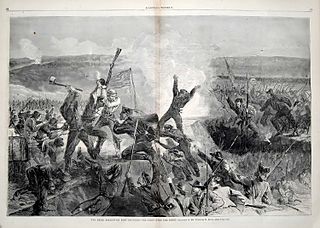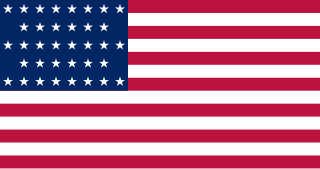
The Battle of Chickamauga, fought on September 18–20, 1863, between Union and Confederate forces in the American Civil War, marked the end of a Union offensive, the Chickamauga Campaign, in southeastern Tennessee and northwestern Georgia. It was the first major battle of the war fought in Georgia, the most significant Union defeat in the Western Theater, and involved the second-highest number of casualties after the Battle of Gettysburg.

The Battle of Missionary Ridge, also known as the Battle of Chattanooga, was fought on November 25, 1863, as part of the Chattanooga Campaign of the American Civil War. Following the Union victory in the Battle of Lookout Mountain on November 24, Union forces in the Military Division of the Mississippi under Maj. Gen. Ulysses S. Grant assaulted Missionary Ridge and defeated the Confederate Army of Tennessee, commanded by Gen. Braxton Bragg, forcing it to retreat to Georgia.

The Battle of Fort Sanders was the crucial engagement of the Knoxville Campaign of the American Civil War, fought in Knoxville, Tennessee, on November 29, 1863. Assaults by Confederate Lt. Gen. James Longstreet failed to break through the defensive lines of Union Maj. Gen. Ambrose Burnside, resulting in lopsided casualties, and the Siege of Knoxville entered its final days.

The Battle of Hoover's Gap was the principal battle in the Tullahoma Campaign of the American Civil War, in which Union General William S. Rosecrans drove General Braxton Bragg’s Confederates out of Central Tennessee. Rosecrans’ feigned move on the western end of the Confederate line had left the eastern mountain passes lightly defended, and Colonel John T. Wilder's mounted infantry achieved total surprise when they attacked Hoover's Gap. Success was attributed both to Rosecrans’ brilliant deception tactics and the high morale of Wilder’s "Lightning Brigade", equipped with the new Spencer repeating rifle.
The Second Battle of Chattanooga was a battle in the American Civil War, beginning on August 21, 1863, as the opening battle in the Chickamauga Campaign. The larger and more famous battles were the Battles for Chattanooga in November 1863.
Stones River National Battlefield, a 570-acre (2.3 km2) park along the Stones River in Rutherford County, Tennessee, three miles (5 km) northwest of Murfreesboro and twenty-eight miles southeast of Nashville, memorializes the Battle of Stones River. This key battle of the American Civil War occurred on December 31, 1862 and January 2, 1863, and resulted in a strategic Union victory.

The Battle of Ringgold Gap was fought November 27, 1863, outside the town of Ringgold, Georgia, by the Confederate and Union armies during the American Civil War. Part of the Chattanooga Campaign, it followed a heavy Confederate loss at the Battle of Missionary Ridge from which General Braxton Bragg's artillery and wagon trains were forced to retreat south. The five hour Battle of Ringgold Gap resulted in the Confederate victory of Major General Patrick R. Cleburne and gave the Army of Tennessee safe passage to retreat through the Ringgold Gap mountain pass.

John Thomas Wilder was an officer in the Union Army during the American Civil War, noted principally for capturing the critical mountain pass of Hoover's Gap during the Tullahoma Campaign in Central Tennessee in June 1863. Wilder had personally ensured that his "Lightning Brigade" of mounted infantry was equipped with the new Spencer repeating rifle. However, Wilder initially had to appeal to his men to pay for these weapons themselves before the government agreed to carry the cost. The victory at Hoover's Gap was attributed largely to Wilder's persistence in procuring the new rifles, which disoriented the enemy.

The 17th Indiana Infantry Regiment, also known as 17th Indiana Mounted Infantry Regiment, was an infantry and mounted infantry regiment that served in the Union Army from 1863 to 1865 during the American Civil War. It served in West Virginia before being transferred to the Western Theater.
The 98th Regiment Illinois Volunteer Infantry, later the 98th Regiment Illinois Volunteer Mounted Infantry, was an infantry and mounted infantry regiment that served in the Union Army during the American Civil War.

The 92nd Regiment Illinois Infantry, also known as 92nd Illinois Mounted Infantry Regiment, was an infantry and mounted infantry regiment that served in the Union Army during the American Civil War.
The 21st Ohio Infantry Regiment was an infantry regiment in the Union Army during the American Civil War. Mostly an all-volunteer unit, with the exception of a few draftees, the 21st Ohio served for both ninety-day and three-year enlistments and fought exclusively in the Western Theater. It saw action in some of the war's bloodiest battles including Stones River, Chickamauga, the Atlanta Campaign, and Sherman's March to the Sea.

The 123rd Regiment Illinois Volunteer Infantry, was an infantry and mounted infantry regiment that served in the Union Army during the American Civil War. In 1863 and 1864 it was temporarily known as the 123rd Illinois Volunteer Mounted Infantry Regiment, as part of Wilder's Lightning Brigade.

The Chattanooga campaign was a series of maneuvers and battles in October and November 1863, during the American Civil War. Following the defeat of Maj. Gen. William S. Rosecrans's Union Army of the Cumberland at the Battle of Chickamauga in September, the Confederate Army of Tennessee under Gen. Braxton Bragg besieged Rosecrans and his men by occupying key high terrain around Chattanooga, Tennessee. Maj. Gen. Ulysses S. Grant was given command of Union forces in the West, now consolidated under the Division of the Mississippi. Significant reinforcements also began to arrive with him in Chattanooga from Mississippi and the Eastern Theater. On October 18, Grant removed Rosecrans from command of the Army of the Cumberland and replaced him with Major General George Henry Thomas.

The 18th Independent Battery Indiana Light Artillery, also known as Lilly's Hoosier Battery and Lilly's Battery, was a civil war regiment formed in Indiana during the American Civil War. The regiment was formed at the end of 1860 by 22-year-old Eli Lilly, an Indianapolis pharmacist. He had recruitment posters placed around the city and recruited primarily among his friends and classmates. The unit contained six 10-pounder Parrott rifles, and was manned by 150 men. The unit mustered in Indianapolis where it was drilled during 1861. Lilly was elected captain of the unit in August 1862 when the unit was deployed to join the Lightning Brigade commanded by Col. John T. Wilder.
The 72nd Indiana Infantry Regiment, also known as 72nd Indiana Mounted Infantry Regiment, was an infantry and mounted infantry regiment that served in the Union Army during the American Civil War. The regiment served as mounted infantry from March 17, 1863, to November 1, 1864, notably as part of the Lightning Brigade during the Tullahoma and Chickamauga Campaigns.

The Ringgold Gap Battlefield, in Catoosa County, Georgia, preserves the scene of the Battle of Ringgold Gap in the American Civil War.
Charles Daniel Saalmann was a captain of Union infantry during the American Civil War. He was wounded at Gettysburg and acted as a Commissary of Subsistence during General William T. Sherman's famed March to the Sea. After the war, he established the Black Rose Vineyard near Egg Harbor City, New Jersey. As a vintner, he produced claret wines that received medals at international competitions.
The 75th Regiment Pennsylvania Volunteer Infantry was a unit of the Union Army during the American Civil War. It was composed almost entirely of German-speaking residents of Philadelphia and newly arrived German immigrants. Total enrollment, over the course of the war, was 1,293 officers and men. The 75th Pennsylvania participated in several major battles including Second Bull Run, Chancellorsville, and Gettysburg. The regiment was transferred to the Western Theater in September, 1863. There, it participated in operations in Tennessee, before it was mustered out of service on September 1, 1865, following the close of the war.

The Lightning Brigade, also known as Wilder's Brigade or the Hatchet Brigade was a mounted infantry brigade from the American Civil War in the Union Army of the Cumberland from March 8, 1863, through November 1863. A novel unit for the U.S. Army, its regiments were nominally the 1st Brigade of Maj. Gen. Joseph J. Reynolds' 4th Division of Thomas' XIV Corps. Operationally, they were detached from the division and served as a mobile mounted infantry to support any of the army's corps. Colonel John T. Wilder was its commander. As initially organized, the brigade had the following regiments:














